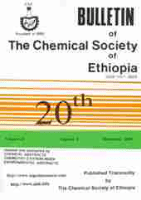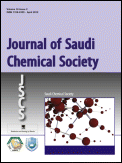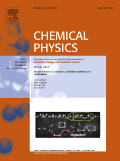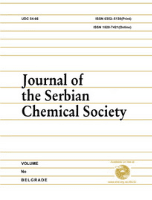
BULLETIN OF THE CHEMICAL SOCIETY OF ETHIOPIA
Scope & Guideline
Illuminating the Path of Chemical Research and Development
Introduction
Aims and Scopes
- Chemical Synthesis and Characterization:
Research articles often detail the synthesis of novel chemical compounds, including organic and inorganic materials, and their characterization using various spectroscopic and analytical techniques. - Biological and Medicinal Chemistry:
The journal highlights studies that investigate the biological activities of synthesized compounds, including their potential as pharmaceuticals, antibacterial agents, and antioxidant properties. - Environmental Chemistry and Sustainability:
Papers addressing environmental issues, such as pollution remediation, the use of natural materials for wastewater treatment, and the impact of chemicals on ecosystems are prevalent. - Nanotechnology and Material Science:
The journal covers research on nanomaterials, their synthesis, characterization, and applications, especially in catalysis, sensors, and environmental remediation. - Theoretical and Computational Chemistry:
Numerous studies employ computational methods to predict molecular behavior, stability, and interactions, contributing to the understanding of chemical phenomena at the molecular level.
Trending and Emerging
- Green Chemistry and Sustainable Practices:
There is a marked increase in research focusing on green chemistry methods, including eco-friendly synthesis processes, waste minimization, and sustainable materials, reflecting the global push towards sustainability. - Nanomaterials and Their Applications:
Research related to the synthesis and application of nanomaterials has surged, particularly in areas such as catalysis, drug delivery, and environmental remediation, highlighting their versatility and potential. - Bioinorganic and Medicinal Chemistry:
The exploration of metal complexes and their biological activities, particularly as anticancer and antibacterial agents, is gaining traction, showcasing the intersection of inorganic chemistry with medicinal applications. - Computational and Theoretical Chemistry:
An increasing number of studies utilize computational methods to predict molecular behavior, enhancing the understanding of chemical interactions and guiding experimental designs. - Biotechnology and Biomaterials:
Research focusing on the use of biological materials and processes in chemical applications, including biosensors and bioremediation, is emerging as a significant area of interest.
Declining or Waning
- Traditional Organic Synthesis Methods:
Research focusing on conventional organic synthesis techniques is becoming less common, with a noticeable shift towards greener and more efficient methods, including biocatalysis and solvent-free reactions. - Basic Analytical Chemistry:
While analytical chemistry remains important, the focus on basic analytical methods without advanced applications or theoretical backing has diminished, as researchers seek more sophisticated or integrated approaches. - Inorganic Chemistry without Biological Relevance:
Studies on inorganic compounds that do not have a direct application in biological systems or environmental contexts are becoming less frequent, as the journal increasingly prioritizes research with clear relevance to health or sustainability.
Similar Journals

Physical Chemistry Research
Fostering collaboration for groundbreaking discoveries in chemistry.Physical Chemistry Research, published by the Iranian Chemical Society, is an esteemed academic journal dedicated to advancing knowledge within the fields of *Fluid Flow and Transfer Processes*, *Physical and Theoretical Chemistry*, and *Statistical and Nonlinear Physics*. Since its inception in 2013, the journal has established a crucial platform for researchers, professionals, and students to share innovative findings and methodologies, enhancing collaboration and knowledge dissemination in the physical chemistry community. With impactful contributions recognized in Quartile 3 and Quartile 4 classifications across various categories, the journal is positioned to cultivate emerging research trends as it continues to converge through 2024. Researchers can benefit from diverse perspectives on crucial phenomena in physical chemistry, as the journal is indexed in prominent databases, further increasing accessibility and visibility. The *open access* policy ensures that cutting-edge research remains available to a broad audience, promoting the growth of the discipline globally.

Chemical Methodologies
Connecting Scholars to Transform Chemical KnowledgeWelcome to Chemical Methodologies, a premier journal published by SAMI PUBLISHING CO-SPC, dedicated to advancing the field of chemistry through innovative research and methodologies. With an ISSN of 2645-7776 and an E-ISSN of 2588-4344, this journal provides a vital platform for researchers and scholars to share their findings in areas encompassing physical, theoretical, and organic chemistry. Despite its initial HIndex and quartile rankings still being established, the journal's evolving impact within the academic landscape is underscored by its Scopus Ranks, which place it in the 35th percentile for physical and theoretical chemistry and the 33rd percentile for organic chemistry. Since its inception in 2022, and continuing through 2024, Chemical Methodologies aims to foster collaboration and knowledge dissemination among academics and practitioners alike, bridging theoretical concepts and practical applications. This open-access platform enhances accessibility for researchers and students worldwide, ensuring that groundbreaking contributions to chemical science reach a broad audience.

JOURNAL OF THE CHILEAN CHEMICAL SOCIETY
Unveiling the Future of Chemistry, One Article at a Time.The Journal of the Chilean Chemical Society, published by the Sociedad Chilena de Química, serves as a premier platform for disseminating significant research findings in the field of Chemistry. With an ISSN of 0717-9707, this journal has established its presence since 2003, providing open access to a diverse range of studies and advancements in this vital scientific domain. It currently holds a Q3 category ranking in Chemistry (miscellaneous) and ranks 196 out of 408 in the general chemistry category on Scopus, indicating its valuable contributions to the field. Through the journal, researchers, professionals, and students are encouraged to engage with cutting-edge research and foster collaboration among the scientific community in Chile and beyond. The society's commitment to excellence ensures that articles published reflect high-quality research, underpinning the journal’s role in shaping knowledge and innovation in chemistry.

ACTA CHIMICA SLOVENICA
Connecting Researchers to Shape the Future of ChemistryACTA CHIMICA SLOVENICA is a distinguished peer-reviewed journal dedicated to advancing the field of chemistry, published by the SLOVENSKO KEMIJSKO DRUSTVO. With an ISSN of 1318-0207 and E-ISSN 1580-3155, this journal has been an essential resource for researchers and professionals since its inception in 1996. Recognized for its commitment to open access since 1998, it fosters global collaboration by making research widely available. Based in Slovenia, the journal operates with a focus on various domains within chemistry, achieving a respectable Q3 ranking in 2023 within the miscellaneous chemistry category on Scopus, showcasing its impact and relevance. This journal serves as a vital platform for innovative research, reviews, and discoveries, aiming to enhance knowledge and ignite curiosity in a diverse readership, including students and emerging scholars in the field.

Journal of the Mexican Chemical Society
Exploring Diverse Disciplines in ChemistryWelcome to the Journal of the Mexican Chemical Society, an essential publication for researchers and professionals in the field of chemistry. Published by the reputable SOC QUIMICA MEXICO, this journal has been a vital platform for sharing innovative research and developments in the field since its inception in 2008. With an ISSN of 1870-249X and an E-ISSN of 1665-9686, the journal provides valuable insights and contributes to the global scientific community. As of 2023, it holds a Q3 quartile ranking in miscellaneous chemistry categories and ranks #258 out of 408 in General Chemistry on Scopus, placing it at the 36th percentile among its peers. Although currently not an open access journal, it remains committed to disseminating high-quality research that supports advancements in chemical education, practice, and technology. Researchers, academics, and students are encouraged to engage with this journal to explore groundbreaking studies and enhance their understanding of diverse chemical disciplines.

CHEMICAL JOURNAL OF CHINESE UNIVERSITIES-CHINESE
Exploring the Depths of Chemical Knowledge.CHEMICAL JOURNAL OF CHINESE UNIVERSITIES-CHINESE, published by Higher Education Press, serves as a vital platform for advancing research in the field of chemistry. With a history dating back to 1996, this journal has evolved to encompass a wide range of topics fundamental to the chemistry community, catering to both applied and theoretical perspectives. Although classified in Quartile 4 within the broader chemistry category, it remains a significant contributor to the knowledge base, ranking 281st out of 408 journals in the general chemistry category according to Scopus. Positioned in Beijing, China, the journal aims to foster collaboration among researchers and professionals while disseminating innovative research and developments. By promoting open exchange of ideas in chemistry, it strives to elevate the scholarly dialogue and contribute to ongoing education for students and professionals alike, with its content accessible through institutional subscriptions.

Journal of Saudi Chemical Society
Fostering Global Collaboration in Chemical Research.The Journal of Saudi Chemical Society, published by ELSEVIER, stands as a premier platform for advancing knowledge in the field of chemistry. Since its inception in 2009, this Open Access journal has garnered significant attention, securing a prestigious Q1 ranking in the Chemistry (miscellaneous) category for 2023, reflecting its position among the top journals in the discipline. With an impressive Scopus ranking of #66 out of 408 in General Chemistry, this journal boasts a commendable 83rd percentile, underscoring its impact and relevance in the global research community. The journal aims to disseminate high-quality research articles, reviews, and case studies, fostering innovation and collaboration among chemists and allied professionals. By enabling widespread access to cutting-edge research, the Journal of Saudi Chemical Society plays a crucial role in supporting the educational and professional development of students, researchers, and practitioners alike, making it an essential resource for anyone invested in the dynamic field of chemistry.

CHEMICAL PHYSICS
Unveiling Chemical Phenomena Through Innovative Research.CHEMICAL PHYSICS is a premier international journal published by Elsevier, dedicated to advancing the field of theoretical and experimental chemistry, particularly within the physical domain. Since its inception in 1973, this journal has served as a platform for disseminating cutting-edge research, fostering collaboration among researchers and professionals in the community. With a notable impact factor and recognized in the Scopus rankings, CHEMICAL PHYSICS holds esteemed positions in two categories: Q3 in Physical and Theoretical Chemistry and Q2 in Physics and Astronomy (miscellaneous). Published in the Netherlands, the journal features high-quality articles that cover a broad spectrum of topics, aiming to deepen understanding of chemical phenomena through innovative approaches. Although open access options are not currently available, the journal remains invaluable for researchers, students, and professionals seeking to stay informed about the latest developments in chemical physics. With convergence years extending from 1973 to 2025, CHEMICAL PHYSICS continues to be a significant contributor to the academic discourse in its field.

JOURNAL OF THE SERBIAN CHEMICAL SOCIETY
Elevating the Standards of Chemical ScholarshipJOURNAL OF THE SERBIAN CHEMICAL SOCIETY, an esteemed publication in the field of chemistry, is published by the SERBIAN CHEMICAL SOCIETY and has been an essential platform for the dissemination of research since 1930. With an ISSN of 0352-5139, this Open Access journal is dedicated to fostering communication and collaboration among chemists worldwide, making its contents readily accessible to researchers, professionals, and students alike. Based in Serbia, the journal features a wide range of topics within the domain of general chemistry, as reflected in its Scopus rankings, which place it in the 34th percentile among its peers. The journal's engagement with the global scholarly community is further underscored by its consistent publication history since 1985, with coverage extending through to 2024. As the journal continues to evolve, it remains committed to promoting high-quality research and advancing the field of chemistry.

Journal of Chemistry
Advancing the Frontiers of Chemical KnowledgeJournal of Chemistry, published by Hindawi Ltd, serves as a critical platform for advancing knowledge in the field of chemistry, particularly in its miscellaneous sub-disciplines. With an impressive 2023 Scopus Rank of #123 out of 408 and positioned in the Q2 quartile, this journal exemplifies a robust academic rigor that appeals to researchers, professionals, and students alike. It features articles related to innovative chemical research and developments, catering to a diverse audience eager to contribute to the growing body of literature in the chemical sciences. The journal has been operational from 2013 to 2024, and its Open Access model ensures that findings are easily accessible to a global audience, fostering collaboration and knowledge sharing. With a commitment to quality and relevance, the Journal of Chemistry continues to play a significant role in shaping contemporary chemical research and education.